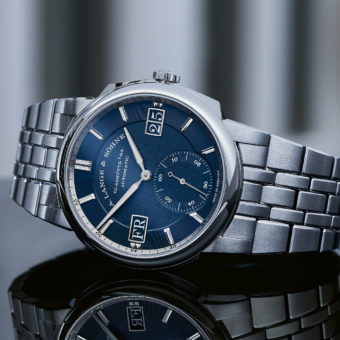There are always watches that receive a great deal of coverage and a great deal of admiration from the media hordes that swarm the Baselworld watch fair every year. And there are always watches that don’t receive nearly as many accolades despite the fact that nearly everyone who sees them agrees they are very cool. The Jaquet Droz Grande Seconde Dual Time, one of my personal favorites from this year’s Baselworld, is one of the latter, its amazingly clever but comparatively “quiet” dual-time-zone complication overshadowed even within its own brand by the latest iteration of the amazing (and decidedly not-quiet) Bird Repeater. Having now had a chance to spend a week with the rose-gold version of this elegant yet eminently useful timepiece, allow me to try to get some buzz going…

At first glance, the watch looks like many other watches from the Jaquet Droz portfolio, with two subdials, one small and one larger, overlapping each other in an attractive figure-eight design. But look more closely and you’ll see that this dial is conveying quite a bit more information than does the standard Grande Seconde, which offers hours and minutes in the top subdial and a large running seconds display in the lower, and even more than the Grande Seconde Quantième, which adds a pointer date function to the large seconds subdial. Essentially, you’re getting four displays in two subdials: local time, reference time, date, and running seconds.

Click below to view a video of the Jaquet Droz Grande Seconde Dual Time Ivory Enamel…
The 18k rose gold case is immaculately polished, with a large dial opening that really allows the dial — here, on this rose-gold model, made of striking, ivory-colored grand feu enamel — to breathe; there is, for all intents and purposes, no real bezel confining the design. The case is water-resistant to 30 meters, not that I would imagine many would be wearing this watch in the swimming pool.

The grooved gold crown, subtly adorned on its top surface with the two stars of the Jaquet Droz logo, pulls out to three positions, and operates the watch’s very user-friendly double-time-zone setting system. First, pull the crown all the way out to its third position and turn it in an upwards direction to set the reference time (the time you’re keeping track of in another time zone) on the larger subdial. This process will simultaneously move the hour and minute hands on the smaller subdial for the local time. To correct the local time, lightly push the crown in to its second position and turn it either upward or downward to move the hands to the proper time. The date is also set easily forward or backward in position two.


Legibility of all of the functions is about as good as one could expect from a watch charged with displaying this many functions on just two subdials: reading the local time on the top subdial’s golden hands is easy, while the large, sweeping seconds hand in the bottom subdial makes it simple to see at a glance if the watch is running. The use of roman numerals in the top subdial and Arabic numerals in the bottom one (including the red “31” date numeral that aids in orientation) is a nice aesthetic touch.
Inevitably, readability diminishes as the numerals on the concentric subdials get smaller. The date, indicated by a red-varnish-tipped pointer on an odd-numbered 1-31 scale, is relatively easy to glean so long as you know, say, what number falls between 13 and 15. The time in a second zone, indicated on a smaller 1-24 scale of blue numerals by a blued-steel hand, requires a bit more of a squint, especially in low light, though younger eyes than mine probably would have less of a problem. One small bit of bad news: the watch has no quick-correct function for the date, so if it’s off by more than a few days, you’ll need quite a few turns of the crown to re-set it.



Turn the watch around and you’ll take in the micromechanical vistas of Jaquet Droz’s Caliber 2663H24, an all-new in-house movement created for this Dual Time watch at the Jaquet Droz manufacture in La Chaux-de-Fonds, Switzerland, the hometown of the brand’s legendary namesake. The skeletonized, fan-like rotor, in this model made of the same rose gold as the case, lets you peek through its openings at the rayonnantes côtes de Genève and perlage decoration on the mainplate and bridges and the oscillations of the balance wheel, with its frequency of 28,800 vph. The movement features a silicon escapement — a feature increasingly prevalent in movements made for the Swatch Group’s luxury brands, of which Jaquet Droz is one — and stores an impressive 65 hours of power reserve in its twin barrels.


Completing the picture is a shiny black alligator strap, with a rose-gold ardillon buckle, which fastens the watch snugly and securely around the wrist. At 43 mm, the case is rather large for a timepiece that is far more elegant than sporty, but the size is appropriate; I can’t imagine how much legibility would have had to be sacrificed on the subdials if they had to be squeezed into a much smaller space. Also, as mentioned above, the clean, non-crowded look of the dial — with large areas of the shimmering ivory enamel surface unencumbered by displays — is one of this watch’s greatest aesthetic assets, in my opinion. And at just over 13 mm thick, it still nestles easily under a shirt cuff.

The price of the Jaquet Droz Grande Seconde Dual Time, which the company tells me will be available at retail in October/November of this year, is $26,800. There is also a steel-cased model with silvered dial for $16,700 and a steel-cased model with a black onyx dial for $17,500. It is an expensive watch that looks and feels expensive, yet never flashy or ostentatious. And that’s not a bad thing at all.






